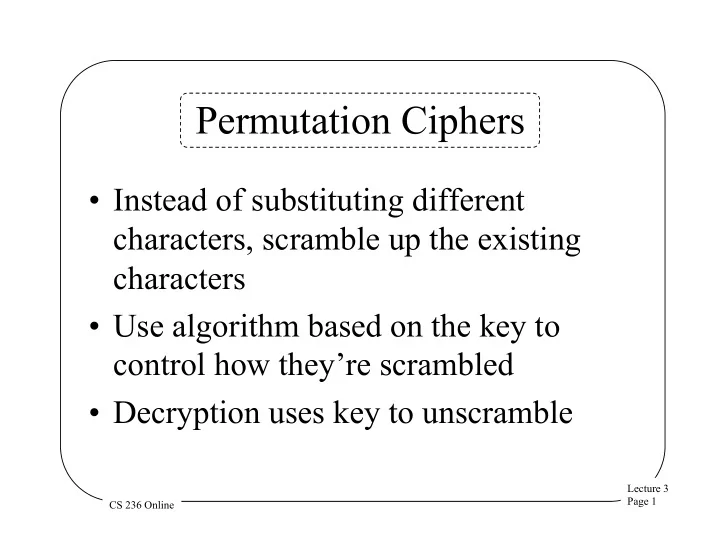

Permutation Ciphers • Instead of substituting different characters, scramble up the existing characters • Use algorithm based on the key to control how they’re scrambled • Decryption uses key to unscramble Lecture 3 Page 1 CS 236 Online
Characteristics of Permutation Ciphers • Doesn’t change the characters in the message – Just where they occur • Thus, character frequency analysis doesn’t help cryptanalyst Lecture 3 Page 2 CS 236 Online
Columnar Transpositions • Write the message characters in a series of columns • Copy from top to bottom of first column, then second, etc. Lecture 3 Page 3 CS 236 Online
Example of Columnar Substitution How did this transformation happen? T e 0 y n c T e 0 y n c T T r a n s f r a n s f r r r g o r g o e r $ 1 0 e r $ 0 l a t s s u a s 0 0 t o m t o m t s u n n $ o a n $ o a n y y s a v i s a v i s 1 v a t s v a t n g s a c l n g s a c f 0 m i c c o u n t f 0 m i c c o u n t Looks a lot more cryptic written this way: Te0yncrr goa tssun$oa ns1 vatf0mic Lecture 3 Page 4 CS 236 Online
Attacking Columnar Transformations • The trick is figuring out how many columns were used • Use information about digrams, trigrams, and other patterns • Digrams are pairs of letters that frequently occur together (“re”, “th”, “en”, e.g.) • For each possibility, check digram frequency Lecture 3 Page 5 CS 236 Online
For Example, 4 5 6 1 2 3 4 5 6 1 2 3 4 5 6 1 2 3 Te0yncrr goa tssun$oa ns1 vatf0mic $ 1 0 0 In our case, the presence of dollar signs and numerals in the text is suspicious Maybe they belong together? Umm, maybe there’s 6 columns? Lecture 3 Page 6 CS 236 Online
Double Transpositions • Do it twice • Using different numbers of columns • How do you break it? – Find pairs of letters that probably appeared together in the plaintext – Figure out what transformations would put them in their positions in the ciphertext • Can transform more than twice, if you want Lecture 3 Page 7 CS 236 Online
Generalized Transpositions • Any algorithm can be used to scramble the text • Usually somehow controlled by a key • Generality of possible transpositions makes cryptanalysis harder Lecture 3 Page 8 CS 236 Online
Which Is Better, Transposition or Substitution? • Well, neither, really • Strong modern ciphers tend to use both • Transposition scrambles text patterns • Substitution hides underlying text characters/bits • Combining them can achieve both effects – If you do it right . . . Lecture 3 Page 9 CS 236 Online
Quantum Cryptography • Using quantum mechanics to perform crypto – Mostly for key exchange • Rely on quantum indeterminacy or quantum entanglement • Existing implementations rely on assumptions – Quantum hacks have attacked those assumptions • Not ready for real-world use, yet • Quantum computing (to attack crypto) even further off Lecture 3 Page 10 CS 236 Online
Recommend
More recommend